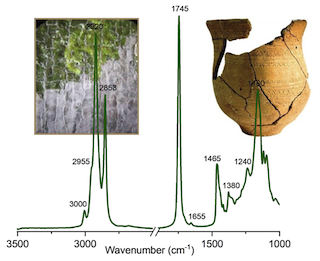In the same section
- Polytech
- EMNS
- Research
- Archaeology & Heritage Sciences
-
Share this page
Methodological Advances in Chemistry for Archaeology & Heritage Sciences
We investigate how organic molecules—particularly lipids—interact with mineral matrices in archaeological ceramics and historical oil paintings. We aim to develop innovative methodologies that can improve our capacity to detect, analyze, and interpret ancient materials, as well as enhance our understanding of their conservation.
#1 Study of the effect of the mineral matrix on lipid absorption, preservation, and extraction from ceramic matrices

Using FTIR, NMR, GC-MS and Atomic Force Microscopy-Infrared Spectroscopy (AFM-IR), we are studying by means of model systems how mineral components like calcium carbonate (CaCO₃) influence lipid absorption, transformation, and extraction. AFM-IR offers the unparalleled potential to map lipid distribution at the nanoscale resolution, to better understand molecular interactions within ceramic matrices.
Head: Prof. Kristin Bartik
Co-workers/researchers: Ms Yaël Antonaros
Collaborations: Dr Alicia Van Ham-Meert (ULB, 4Mat); Prof. Jehan Waeytens (ULB, School of Pharmacy), Dr. Francisco Mederos-Henry (KIK-IRPA and ULB, CReA-Patrimoine); Prof Alexandre Dazzi (Université Paris Saclay); Dr Jasmin Lundy (University of York); Prof. Rachel Wood (University of Oxford).
Funding: ULB (Action Blanche)
Communications:
Influence of the Ceramic Matrix on Lipid Retention and Extraction from Archaeological Potteries
Yaël Antonaros, Jehan Waeytens, Kristin Bartik & Alicia Van Ham-Meert
11th International Symposium on Biomolecular Archaeology, Turin (Italy), 26-29 August 2025 (Poster and Oral Communication)
Influence of the Ceramic Matrix on Lipid Retention and Extraction from Archaeological Potteries: Insights from Infrared Spectroscopy
Yaël Antonaros, Jehan Waeytens, Alicia Van Ham-Meert & Kristin Bartik
Journées Scientifiques du Groupe Français de Spectroscopies Vibrationnelles, Saint-Malo (France), 21-22 May 2025
#2 Study of carboxylate-mediated degradation mechanisms in historical oil paintings
Investigating the long-term stability of lipids in historical oil paintings is crucial for developing effective conservation strategies to prevent degradation and preserve these artworks for future generations. Metal oxalates, formed through complex chemical interactions between an oil binder and paint materials, are considered particularly problematic as they can precipitate on a painting’s surface, forming a thick, opaque, highly insoluble crust, which radically modifies the artwork’s visual properties and alter their readability.
Using FTIR and AFM-IR, we investigate the formation mechanisms of metal oxalates in historical oil paintings through model systems aged under controlled conditions.
Communication:
Study on the formation mechanism of metal oxalates in historical oil paintings by means of model systems: the role of environmental conditions & linseed oil’s moieties
Rojo-Adalid C., Colignon A., Belenguer-Salvador C., Waeytens J., Bartik K., Sanyova J. & Mederos-Henry F.
International Conference on Analytical Techniques for Heritage Studies and Conservation, Perugia (Italy), 6-9 May 2025 (Oral Communication)
